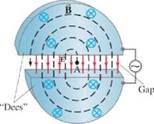
Concept explainers
The cyclotron (Fig. 20-72?) is a device used to accelerate elementary particles such as protons to high speeds.Particles starting at point A with some initial velocity travel in semicircular orbits in the magnetic field B.The particles are accelerated to higher speeds each time they pass through the gap between the metal “dees ” where there is an electric field E. (There is no electric field inside the hollow metal dees where the electrons move in circular paths.) The electric field changes direction each half-cycle, owing to an ac voltage

Figure 20-72
Want to see the full answer?
Check out a sample textbook solution
Chapter 20 Solutions
EP PHYSICS: PRIN.APP.AP-MOD.MASTERING
- A proton enters a region with a uniform electric field E=5.0kV/m and a uniform magnetic field B=5.0104kT. The proton has initial velocity v0=2.5105m/s. How far along the z axis does the proton travel after it undergoes three complete revolutions?arrow_forwardA cosmic-ray proton in interstellar space has an energy of 10.0 MeV and executes a circular orbit having a radius equal to that of Mercury’s orbit around the Sun (5.80 × 1010 m). What is the magnetic field in that region of space?arrow_forwardWhat magnetic field is required in order to confine a proton moving with a speed of 4.0 × 106 m/s to a circular orbit of radius 10 cm?arrow_forward
- Hall potentials are much larger for poor conductors than for good conductors. Why?arrow_forwardA particle of charge q and mass m is accelerated from rest through a potential difference V, after silica it encounters a uniform magnetic field B. If the particle moves in a plane perpendicular to B, shaft is the radius of its circular orbit?arrow_forwardIf a charged particle moves in a straight line, can you conclude that there is no magnetic field present?arrow_forward
- A 1.00-kg ball having net charge Q = 5.00 C is thrown out of a window horizontally at a speed v = 20.0 m/s. The window is at a height h = 20.0 m above the ground. A uniform horizontal magnetic field of magnitude B = 0.010 0 T is perpendicular to the plane of the balls trajectory. Find the magnitude of the magnetic force acting on the ball just before it hits the ground. Hint: Ignore magnetic forces in finding the balls final velocity.arrow_forwardElectrons in Earths upper atmosphere have typical speeds near 6.00 105 m/s. (a) Calculate the magnitude of Earths magnetic field if an electrons velocity is perpendicular to the magnetic field and its circular path has a radius of 7.00 102 m. (b) Calculate the number of times per second that an electron circles around a magnetic field line.arrow_forwardA cosmic-ray electron moves at 7.5 × 106 m/sinches perpendicular to Earth’s magnetic field at an altitude queer the field strength is 1.0 × 105T. What is the radius of the circular path the electron follows?arrow_forward
- A thin, nonconducting disk of radius R is free to rotate around the axis that passes through its center and is perpendicular to the face of the disk. The disk is charged uniformly with a total charge q. If the disk rotates at a constant angular velocity , what is tire magnetic field at its center?arrow_forward, A proton, deuteron, and an alpha-particle ae all accelerated from rest through the same potential difference. They then enter the same magnetic field, moving perpendicular to it. Compute the ratios of the radii of their circular paths. Assume that md= 2wmp and ma= 4mp.arrow_forwardA particle of charge +q and mass m moves with velocity v0 pointed In the +y-direction as It crosses the x-axis at x= R at a particular time. There is a negative charge -Q fixed at the origin, and there exists a uniform magnetic field B0 pointed in the +z-direction. It is found that the particle describes a circle of radius R about -Q. Find B0 in terms of the given quantities.arrow_forward
 Principles of Physics: A Calculus-Based TextPhysicsISBN:9781133104261Author:Raymond A. Serway, John W. JewettPublisher:Cengage Learning
Principles of Physics: A Calculus-Based TextPhysicsISBN:9781133104261Author:Raymond A. Serway, John W. JewettPublisher:Cengage Learning Glencoe Physics: Principles and Problems, Student...PhysicsISBN:9780078807213Author:Paul W. ZitzewitzPublisher:Glencoe/McGraw-Hill
Glencoe Physics: Principles and Problems, Student...PhysicsISBN:9780078807213Author:Paul W. ZitzewitzPublisher:Glencoe/McGraw-Hill College PhysicsPhysicsISBN:9781938168000Author:Paul Peter Urone, Roger HinrichsPublisher:OpenStax College
College PhysicsPhysicsISBN:9781938168000Author:Paul Peter Urone, Roger HinrichsPublisher:OpenStax College College PhysicsPhysicsISBN:9781305952300Author:Raymond A. Serway, Chris VuillePublisher:Cengage Learning
College PhysicsPhysicsISBN:9781305952300Author:Raymond A. Serway, Chris VuillePublisher:Cengage Learning College PhysicsPhysicsISBN:9781285737027Author:Raymond A. Serway, Chris VuillePublisher:Cengage Learning
College PhysicsPhysicsISBN:9781285737027Author:Raymond A. Serway, Chris VuillePublisher:Cengage Learning Physics for Scientists and Engineers: Foundations...PhysicsISBN:9781133939146Author:Katz, Debora M.Publisher:Cengage Learning
Physics for Scientists and Engineers: Foundations...PhysicsISBN:9781133939146Author:Katz, Debora M.Publisher:Cengage Learning





